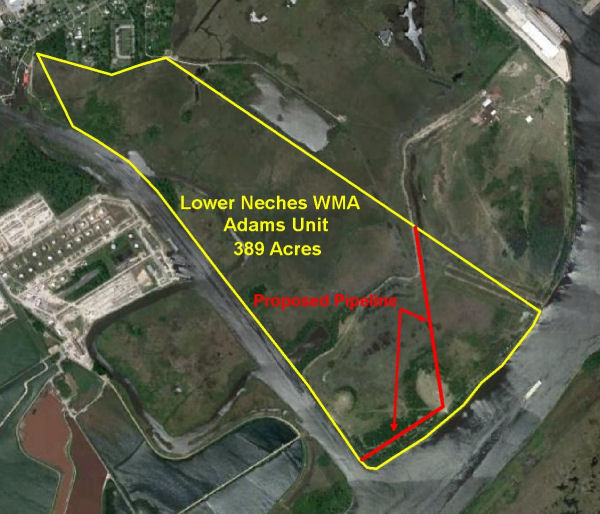Work Session
Wednesday, August 21, 2013
9:00 a.m.
Texas Parks and Wildlife Department
Commission Hearing Room
4200 Smith School Road, Austin, TX 78744
Chairman T. Dan Friedkin, Commission Chair
Carter Smith, Executive Director
Approval of the Previous Minutes from the Work Session held May 22, 2013
- Update on TPWD Progress in Implementing the TPWD Land and Water Resources Conservation and Recreation Plan—Carter Smith
- Easement Renewals
- Publication in the Texas Register of Minor Changes to Rules Necessitated by Legislation Passed during the 83rd Texas Legislature
- Publication in the Texas Register of Changes to Rules concerning Implementation of Legislation Passed during the 83rd Texas Legislature—Senate Bill 820—Multi Year Deer Breeder Permit
- Early Season Migratory Game Bird Update
- Red Snapper Update
- Internal Affairs Update
- Financial Overview—Justin Halvorsen (Action Item No. 2)
- Internal Audit Report—Cindy Hancock
- Personnel Matters—Dawn Heikkila (Executive Session Item No. 1)
- Performance Evaluation of TPWD Executive Director
- Discuss Executive Director Compensation Authorized by S.B. 1, as enacted by the 83rd Texas Legislature (2013) (Action Item No. 13)
- Briefing on the Prohibition of the Use of Noxious or Toxic Substances to Capture Nongame Wildlife—John Davis
- Commercially Protected Finfish Reporting Requirements—Mandatory Electronic Reporting—Recommended Adoption of Proposed Changes—Brandi Reeder (Action Item No. 3)
- Possession of Undersize Oysters—Recommended Adoption of Proposed Changes—Brandi Reeder (Action Item No. 4)
- Exotic Species Rule Amendments regarding Draining Water from Vessels and Portable Containers—Implementation of Legislation Passed During the 83rd Texas Legislature—Relating to House Bill 1241—Request Permission to Publish Proposed Changes in the Texas Register—Ken Kurzawski
- Use of Dogs to Trail Wounded Deer—Recommended Adoption of Proposed Changes—Scott Vaca (Action Item No. 5)
- WITHDRAWN—Potential Black-footed Ferret Reintroduction—Calvin Richardson
- Hunter Education Course Requirements—Recommended Adoption of Proposed Changes—Nancy Herron, Robert Ramirez (Action Item No. 8)
- Land Acquisition—Gonzales County—Approximately 11 Acres as an Addition to Palmetto State Park—Lana Marbach (Action Item No. 10)
- WITHDRAWN—Land Acquisition—Cochran County—Approximately 1,640 Acres at Yoakum Dunes Preserve—Corky Kuhlmann (Action Item No. 12)
- Request for Easement—Orange County—Crude Oil Transmission Line on the Lower Neches Wildlife Management Area—Request Permission to Begin the Public Notice and Input Process—Ted Hollingsworth
- Request for Easement—Orange County—Gathering Line on the Lower Neches Wildlife Management Area—Request Permission to Begin the Public Notice and Input Process—Ted Hollingsworth
Land and Water Plan
Financial
Natural Resources Regulations
Land Conservation—Land Acquisition
Land Conservation—Pipeline Easements
Work Session Item No. 1
Presenter:
Carter Smith
Work Session
TPWD Land and Water Resources Conservation and Recreation Plan
August 21, 2013
I. Executive Summary: Executive Director Carter Smith will briefly update the Commission on the status of the agency’s efforts to implement the Land and Water Resources Conservation and Recreation Plan (the “Plan”).
II. Discussion: In 2001, the 77th Texas Legislature directed that the Texas Parks and Wildlife Department (TPWD) develop a Land and Water Resources Conservation and Recreation Plan (Tex. Park & Wild. Code §11.104). In 2002, the Texas Parks and Wildlife Commission (the Commission) adopted the first Plan. A revised Plan was adopted by the Commission in January 2005. In November 2009, the Commission approved a new Plan effective January 1, 2010. The 2010 Plan is available on the TPWD web site. Executive Director Carter Smith will update the Commission on TPWD’s recent progress in achieving the Plan’s goals, objectives and deliverables.
The Plan consists of the following four goals:
- Practice, Encourage and Enable Science-based Stewardship of Natural and Cultural Resources
- Increase Access To and Participation In the Outdoors
- Educate, Inform and Engage Texas Citizens in Support of Conservation and Recreation
- Employ Efficient, Sustainable and Sound Business Practices
Work Session Item No. 2
Presenter:
Justin Halvorsen
Work Session
Financial Overview
August 21, 2013
I. Executive Summary: Staff will present a summary of the FY 2014 Operating and Capital Budget, a summary project list for Capital and Conservation Accounts, the Commission’s Budget and Investment policies, and a list of state parks for use for Legislative Budget Board (LBB) performance measures.
II. Discussion:
- Staff will present and discuss the TPWD FY 2014 Operating and Capital Budget including a proposed project list for funding from the Capital Conservation Account.
- Staff will summarize the Commission’s Budget Policy and the Investment Policy both of which remain unchanged from FY 2013.
- Staff will present a State Parks list for use in calculating LBB performance measures
- Staff will present the recommended motion for consideration and action by the Commission on August 21, 2013 to approve:
- The TPWD FY 2014 Operating and Capital Budget (by strategy and by object-of-expense);
- The proposed project list for expenditures from the Capital Conservation Account;
- The TPW Commission Budget Policy;
- The TPW Commission Investment Policy: and
- The TPWD list of State Parks for use in calculating the LBB performance measure for “Number of State Parks in Operation” over the 2014-15 biennium.
Work Session Item No. 3
Presenter:
Cindy Hancock
Work Session
Internal Audit Report Update
August 21, 2013
- Executive Summary: Staff will provide a status report on the TPWD FY13 Internal Audit Plan and ongoing or completed external audits.
- Discussion: Staff will present a status report on the TPWD FY13 Internal Audit Plan as well as external audits that have been completed and/or are ongoing. A short summary of the results will be provided for completed assurance projects.
Work Session Item No. 5
Presenter:
John Davis
Work Session
Prohibition of the Use of Noxious or Toxic Substances
to Capture Nongame Wildlife
August 21, 2013
- Executive Summary: Staff will brief the Commission on the ecological effects of the use of stupefying, noxious, or toxic substances to capture nongame wildlife. The department has received a petition for rulemaking requesting the prohibition of the practice of using gasoline to drive rattlesnakes from underground.
- Discussion: Under Parks and Wildlife Code, Chapter 67, the department is required to “develop and administer management programs to ensure the continued ability of nongame species of fish and wildlife to perpetuate themselves successfully.” (Texas Parks and Wildlife Code §67.002(a). Chapter 67 also provides the commission with the authority to “establish any limits on the taking, possession, propagation, transportation, importation, exportation, sale, or offering for sale of nongame fish or wildlife that the department considers necessary to manage the species.” (Texas Parks and Wildlife Code §67.004(a).
The practice of using gasoline or other stupefying, noxious, or toxic substances to drive snakes from underground or hiding places for purposes of capture has been prohibited in many states. The primary purpose of such prohibitions is to protect non-target species such as other snakes, toads and frogs, tortoises and turtles, burrowing avian life, and other species of invertebrates. These species are extremely sensitive to chemical irritants, and exposure interrupts life cycles, disturbs food webs, and causes mortalities both directly and indirectly.
Work Session Item No. 8
Presenter:
Ken Kurzawski
Work Session
Exotic Species Rule Amendments regarding
Draining Water from Vessels on Public Water—Implementation of
Legislation Passed in the 83rd Texas Legislature
August 21, 2013
- Executive Summary: Staff will seek permission to publish in the Texas Register for public comment proposed new rules governing the draining of water from vessels on public water. The proposed new rules will implement legislative authority delegated to the Commission under the provisions of House Bill (H.B.) 1241, enacted by the 83rd Texas Legislature (2013, Regular Session). The proposed new rules would:
- require a person who leaves or approaches a public water body in specific counties to drain all water from a vessel or portable containers, including all live wells, bilges, and other similar receptacles and systems that are capable of retaining or holding water as a consequence of being immersed in public water;
- list the activities that are exempt from these rules;
- list the counties where the rules would be in effect, if adopted; and
- make nonsubstantive conforming changes to accommodate the proposed new rule.
- Discussion: Under Parks and Wildlife Code, Chapter 66, the Commission is required to promulgate rules regarding the importation, possession, sale, or placement into public waters of exotic harmful or potentially harmful fish or shellfish. Under the provisions of H.B. 1241, which amended the Parks and Wildlife Code by adding new §66.0073, the Commission is authorized to adopt rules requiring a person leaving or approaching public water to drain from a vessel or portable container on board the vessel any water that has been collected from or has come in contact with public water
The proposed new rule (Located at Exhibit A) is intended primarily to control the spread of zebra mussels (Dreissena polymorpha). The zebra mussel is a small, non-native mussel originally found in Eurasia. It has spread throughout Europe and the U.S. and is considered to be a major environmental and industrial threat. Zebra mussels are particularly difficult to control because they have a free-floating, microscopic larval stage called a veliger. Any water collected from waterbodies where zebra mussels are present could contain veligers; thus, water transported from waterbodies with known zebra mussel populations is a vector for the spread of zebra mussels.
Work Session Item No. 8
Exhibit A
RULES REQUIRED OR AUTHORIZED BY LEGISLATION
DRAINING OF WATER FROM VESSELS
PROPOSAL PREAMBLE
1. Introduction.
The Texas Parks and Wildlife Department proposes an amendment to §57.792, concerning General Provisions; new §57.1000, concerning Prohibited Transport of Live Nongame Fish; and new §57.1001, concerning Draining of Water from Vessels Leaving or Approaching Public Fresh Water. Proposed new §57.1000 and §57.1001 would comprise new Division Four under Subchapter N, to be entitled Special Provisions to Prevent the Spread of Exotic Aquatic Species.
The proposed amendment to §57.972, concerning General Rules, would remove current subsection (j), which prohibits the transport of live nongame fish from certain bodies of water, and subsection (k), which establishes an exception to the prohibition on possession of exotic shellfish. Proposed new §57.1001 would consist of the contents of current §57.972(j) verbatim. Proposed new §57.1001, would require water contained in vessels or in receptacles aboard vessels to be drained prior to leaving or approaching public water in 17 counties with watersheds where zebra mussels either have been discovered or are so close to compromised watersheds that restrictions on the transportation of water are warranted. The proposed new rule replaces the provisions of §57.972(k).
Invasive exotic species are non-indigenous species that have been accidentally or intentionally released into an ecosystem. In the worst cases, invasive species, because they are not checked by natural competition or predators, compete directly with, prey upon, or hybridize with native species, alter habitats and food webs, threaten rare species, and generally wreak ecological havoc. Besides the obvious negative impacts to wild ecosystems, invasive exotic species also threaten agriculture, ranching, forestry, and industry.
Current §57.972(j), being proposed as new §57.1000, was promulgated in 2012 to address the spread of silver and bighead carp, invasive species that have become problems to native species and ecosystems elsewhere. At the current time, these species are present in Texas in limited numbers or are confined to few locations. Although possession and transport of these species is prohibited under current rules (31 TAC Chapter 57, Subchapter A), the department determined that additional regulations were needed to prevent the accidental or incidental movement of these species from one water body to another. By prohibiting the transport of live, nongame fishes from infested water bodies, the department intended to prevent the accidental capture and movement of silver and bighead carp as a result of bait-collecting activities for other nongame fishes, especially gizzard or threadfin shad, which are quite similar in appearance.
In 2012 the department also promulgated §57.792(k) to control the spread of zebra mussels from a section of the Red River and Lake Lavon to adjacent water bodies. The zebra mussel is a small, non-native mussel originally found in Eurasia. It has spread throughout Europe, where it is considered to be a major environmental and industrial menace. The animal appeared in North America in the late 1980s and within ten years had colonized in all five Great Lakes and the Mississippi, Tennessee, Hudson, and Ohio river basins. Since then, they have spread to additional lakes and river systems. Once zebra mussels become established in a water body, they are impossible to eradicate with the technology available today. In 2012 the only regulatory tool available to the department was Parks and Wildlife Code, §66.007, which prohibits the possession of exotic harmful or potentially harmful fish or shellfish except as authorized by permit or rule. Since zebra mussels are a species that cannot be possessed without a permit, it is technically unlawful to possess even the microscopic larval stage of the organism, which can be present virtually everywhere in an infested water body. The provisions of §57.972(k) provided that a person could not be charged with unlawful possession of a prohibited species provided the person drained all live wells, bilges, and other receptacles or systems capable of retaining or holding water prior to the use of a public roadway.
The 83rd Texas Legislature (Regular Session) enacted House Bill 1241, which amended Parks and Wildlife Code by adding new §66.0073 to authorize the Texas Parks and Wildlife Commission to adopt rules requiring a person leaving or approaching public water to drain from a vessel or portable container on board the vessel any water that has been collected from or has come in contact with public water. The department has determined that it is preferable to have a regulation that simply requires water to be drained from boats and receptacles than to rely on a regulation that is predicated on proving the possession of an organism that cannot be seen with the unaided eye. Therefore, current §57.972(k) is being eliminated and replaced with new §57.1001.
Proposed new §57.1001 would prohibit, with exceptions, the use of a public roadway other than a boat ramp to transport a vessel to or from a public water body in any of 17 counties unless all bilges, live wells, and other similar receptacles and systems holding or capable of holding water on board the vessel as a result of immersion in or transfer from a public water body have been drained. By requiring the draining of water that could contain zebra mussel larvae prior to leaving or approaching a water body, the likelihood of zebra mussels being transferred from an infested water body to another water body is reduced.
The provisions of House Bill 1241 require the commission to consider the effects of rules on boaters, anglers, and local interests while maintaining the ability to prevent the spread of harmful or potentially harmful exotic fish, shellfish, and aquatic plants. Therefore, the proposed new rule would create exceptions for persons (such as anglers or boaters) who travel by road from one point on an infested water body to another point on that water body within a 24-hour period; government employees or subcontractors in the performance of official duties that involve water collection in a portable container, emergencies involving a threat to human health or safety, or property; water contained in sanitation systems, and live bait obtained from a commercial bait seller (provided the possessor possesses documentation as the origin of the water). The department’s goal is to prevent the spread of zebra mussels; however, the department believes that the rule should not be onerous. For instance, live bait is important to many anglers, and many businesses near lakes and rivers sell live bait to anglers. The department does not wish to interfere with or impede such business activity; therefore, the proposed new rule allows the possession of water incidental to the possession of live bait, provided the possessor has documentation attesting to the location where the bait was purchased. Similarly, many anglers, boaters, guides, and other persons engaged in water-related recreation find it necessary or desirable to trailer boats around the perimeter of a water body to multiple access points for various reasons. The department does not wish to inconvenience persons who need or desire to access a water body at multiple locations; therefore, the proposed new rule would allow the retention of water within boats and receptacles aboard boats by persons travelling on a public roadway via the most direct route to another access point located on the same body of water, provided the beginning and ending of the travel occur within a single 24-hour period. The 24-hour limitation was selected because it represents one day’s activity. The department reasons that at the end of a day’s activity, a person can drain live wells, bilges, etc., before leaving the water body without being inconvenienced. Without a time limit of some kind the department is not assured that persons will drain bilges, live wells, etc., prior to travelling to a water body where zebra mussels have not been found.
Proposed new 57.1001(3) lists 17 counties where the regulation would be in effect (Collin, Cooke, Dallas, Denton, Fannin, Grayson, Hood, Jack, Kaufman, Montague, Palo Pinto, Parker, Rockwall, Stephens, Tarrant, Wise, and Young). The department has confirmed the presence of zebra mussels in Lake Texoma and the upper reaches of the Trinity River basin, including several major lakes. In order to prevent zebra mussels from spreading into other water bodies adjacent to Lake Texoma and within the Trinity River basin, the proposed new rule includes the counties that border Lake Texoma and the immediate downstream reach of the Red River (Cooke, Fannin, and Grayson) and all counties within the watershed of the upper Trinity River (Collin, Dallas, Denton, Jack, Kaufman, Montague, Rockwall, Tarrant, and Wise). Additionally, the proposed new rule would include counties in the Brazos River basin that have water bodies very close to the Trinity River watershed (Hood, Palo Pinto, Parker, Stephens, and Young).
2. Fiscal Note.
Ken Kurzawski, Inland Fisheries Division Program Director, has determined that for each of the first five years that the rules as proposed are in effect, there will be no fiscal implications to state and local governments as a result of enforcing or administering the rules.
3. Public Benefit/Cost Note.
Mr. Kurzawski also has determined that for each of the first five years the rules as proposed are in effect:
(A) The public benefit anticipated as a result of enforcing or administering the rules as proposed will be the protection of public waters from the injurious environmental and economic effects of invasive exotic species.
(B) There will be no adverse economic effect on persons required to comply with the rules as proposed.
(C) Under the provisions of Government Code, Chapter 2006, a state agency must prepare an economic impact statement and a regulatory flexibility analysis for a rule that may have an adverse economic effect on small businesses and micro-businesses. As required by Government Code, §2006.002(g), the Office of the Attorney General has prepared guidelines to assist state agencies in determining a proposed rule’s potential adverse economic impact on small businesses. Those guidelines state that an agency need only consider a proposed rule’s “direct adverse economic impacts” to small businesses and micro-businesses to determine if any further analysis is required. For that purpose, the department considers “direct economic impact” to mean a requirement that would directly impose recordkeeping or reporting requirements; impose taxes or fees; result in lost sales or profits; adversely affect market competition; or require the purchase or modification of equipment or services. Since the proposed rules affect only those persons who approach or depart from a body of public water and there is no cost of compliance (because the rule requires only that water receptacles be drained), the department has determined that the proposed amendments will not impose any direct adverse economic effects on small businesses or microbusinesses. Accordingly, the department has not prepared a regulatory flexibility analysis under Government Code, Chapter 2006.
(D) The department has not drafted a local employment impact statement under the Administrative Procedures Act, §2001.022, as the agency has determined that the rules as proposed will not impact local economies.
(E) The department has determined that there will not be a taking of private real property, as defined by Government Code, Chapter 2007, as a result of the proposed rules.
4. Request for Public Comment.
Comments on the proposed rule may be submitted to Ken Kurzawski, Texas Parks and Wildlife Department 4200 Smith School Road, Austin, Texas, 78744; (512) 389-4591 (e-mail: ken.kurzawski@tpwd.texas.gov).
5. Statutory Authority.
The amendment is proposed under the authority of Parks and Wildlife Code, §66.007, which prohibits the possession or placement into public waters of exotic fish or shellfish except as authorized by rule or permit issued by the department, and under Parks and Wildlife Code, §66.0073, added by House Bill 1241 as enacted by the 83rd Texas Legislature (Regular Session), which authorizes the commission to adopt rules requiring a person leaving or approaching public water to drain from a vessel or portable container on board the vessel any water that has been collected from or has come in contact with public water.
The proposed amendment affects Parks and Wildlife Code, Chapter 66.
6. Rule Text.
§57.972. General Rules.
(a)- (i) (No change.)
[(j) No person may leave a body of water listed in this subsection while in possession of a live nongame fish:]
[(1) the Red River below Lake Texoma downstream to the Texas/Arkansas border;]
[(2) Big Cypress Bayou downstream of Ferrell’s Bridge Dam on Lake O’ the Pines, including the Texas waters of Caddo Lake; and]
[(3) the Sulphur River downstream of the Lake Wright Patman dam to the Texas/Arkansas border.]
[(k) A person who leaves a water body listed in this subsection while in possession of a harmful or potentially harmful species listed in §57.111 of this title (relating to Definitions) that is invisible to the unaided human eye is not in violation of §57.112 of this title (relating to General Rules), provided that:]
[(1) all live wells, bilges, and other similar receptacles and systems that are capable of retaining or holding water as a consequence of being immersed in a water body have been drained prior to the use of a public roadway; or]
[(2) the person is travelling on a public roadway via the most direct route to another access point located on the same body of water.]
[(3) This subsection applies to the following bodies of water:]
[(A) the Red River from the I-44 bridge in Wichita County to the Texas/Arkansas border, including the Texas waters of Lake Texoma;]
[(B) Lake Lavon; and]
[(C) all impounded and tributary waters of the Elm Fork of the Trinity River above the Lewisville Dam, including Lake Lewisville and Lake Ray Roberts.]
This agency hereby certifies that the proposal has been reviewed by legal counsel and found to be within the agency’s authority to adopt.
Issued in Austin, Texas on
The new rules are proposed under the authority of Parks and Wildlife Code, §66.0073
The proposed new rules affect Parks and Wildlife Code, Chapter 57, Subchapter N.
§57.1000. Prohibited Transport of Live Nongame Fish. No person may leave a body of water listed in this subsection while in possession of a live nongame fish:
(1) the Red River below Lake Texoma downstream to the Texas/Arkansas border;
(2) Big Cypress Bayou downstream of Ferrell’s Bridge Dam on Lake O’ the Pines, including the Texas waters of Caddo Lake; and
(3) the Sulphur River downstream of the Lake Wright Patman dam to the Texas/Arkansas border.
§57.1001. Draining of Water from Vessels Leaving or Approaching Public Fresh Water. For the purposes of this section, “boat ramp” means a boat ramp, launch area, or access point that can be used to access public water, and includes parking areas, parking overflow areas, and any other area in the immediate vicinity of the ramp, launch, or access point where a vehicle, trailer, or vessel may be parked while waiting to launch or retrieve a vessel.
(1) General Provisions. Except as provided in paragraph (2) of this subsection, no person may use any public roadway other than a boat ramp to transport a vessel to or from a public water body in a county listed in paragraph (3) of this subsection unless all bilges, live wells, and other similar receptacles and systems holding or capable of holding water on board the vessel as a result of immersion in or transfer from the public water body have been drained.
(2) Exceptions. The provisions of paragraph (1) of this subsection do not apply to:
(A) a person travelling on a public roadway via the most direct route to another access point located on the same body of water, provided the beginning and ending of the travel occur within a single 24-hour period;
(B) government employees or persons under contract to a governmental entity in the performance of official duties that involve:
(i) the use of a vessel to collect water in portable containers ;
(ii) the use of a vessel in an emergency response to a threat to human health or safety, or property;
(C) water contained in marine sanitary systems; or
(D) receptacles containing live bait purchased from a commercial bait seller, provided the person in possession of the water also possesses a dated receipt, bill of sale, or other written evidence that identifies the name and commercial location of the seller.
(3) This subsection applies to all public water in Collin, Cooke, Dallas, Denton, Fannin, Grayson, Hood, Jack, Kaufman, Montague, Palo Pinto, Parker, Rockwall, Stephens, Tarrant, Wise, and Young counties.
This agency hereby certifies that the proposal has been reviewed by legal counsel and found to be within the agency’s authority to adopt.
Issued in Austin, Texas on
Work Session Item No. 14
Presenter:
Ted Hollingsworth
Work Session
Request for Pipeline Easement—Orange County
Crude Oil Transmission Line on the
Lower Neches Wildlife Management Area
August 21, 2013
- Executive Summary: Shell Pipeline Company LP requests an easement to cross the Adams Bayou Unit of the Lower Neches Wildlife Management Area (WMA) with a 36” diameter crude oil transmission pipeline.
- Discussion: Shell Pipeline Company LP (Shell) plans to construct a 36” diameter pipeline, known as the “Westward Ho” Pipeline, for the transportation of crude oil 204 miles from St. James, Louisiana to Port Neches, Texas. Approximately 18.6 miles of the pipeline will be located in Texas, of which 2,732 feet (166 rods) is proposed to cross the Adams Bayou Unit of the Lower Neches WMA. The segment of the pipeline that crosses the WMA is to be directionally drilled, with a single exit/entry bore pit location and associated access, pipe stringing and related temporary workspaces on the WMA.
Shell has submitted to Texas Parks and Wildlife Department (TPWD) an alternatives analysis and draft work plan for the pipeline in Texas, suggesting that alternative routes are unsafe or would cause greater environmental damage. TPWD staff is in the process of reviewing the analysis and construction methodologies to assure that impacts to the WMA are avoided or minimized. Staff will likewise be evaluating alternatives for mitigation of environmental impacts from the pipeline in Texas to avoid and minimize any loss of fish and wildlife resources. Staff requests permission to begin the public notice and input process regarding the requested easement.
Attachments – 3
Work Session Item No. 14
Exhibit A
Location Map for Lower Neches WMA in Orange County
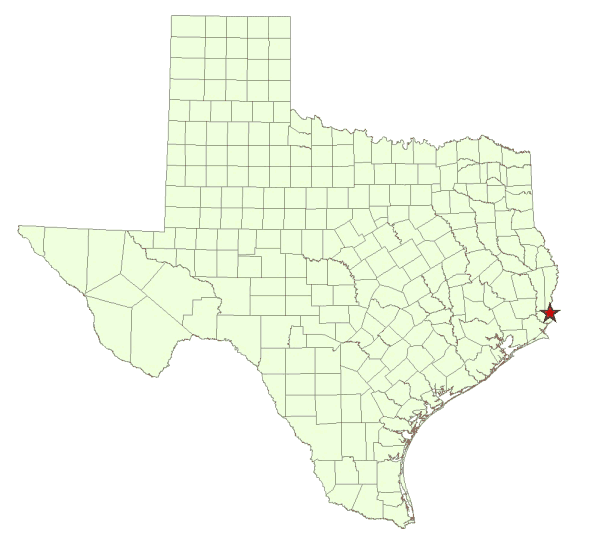
Work Session Item No. 14
Exhibit B
Vicinity Map for Adams Unit Lower Neches WMA in Orange County
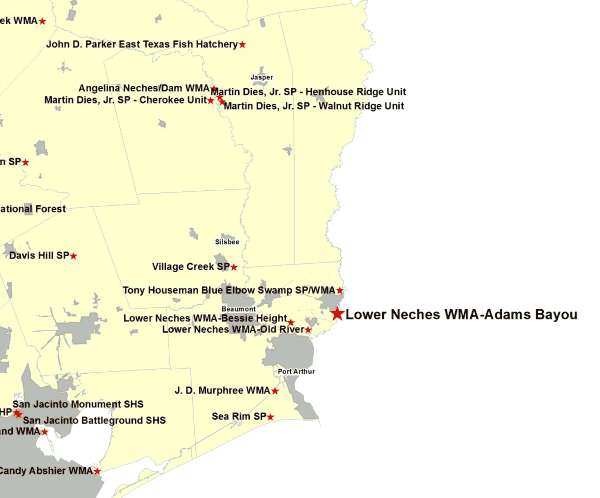
Work Session Item No. 14
Exhibit C
Site Map Showing Proposed Pipeline Easement
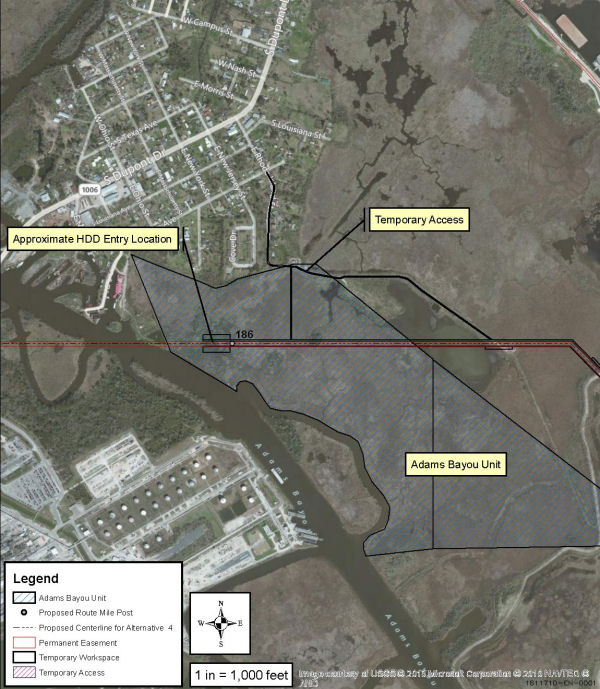
Work Session Item No. 15
Presenter:
Ted Hollingsworth
Work Session
Request for Pipeline Easement—Orange County
Gathering Line on the Lower Neches Wildlife Management Area
August 21, 2013
- Executive Summary: Lake Ronel Oil Company requests an easement to cross the Adams Bayou Unit of the Lower Neches Wildlife Management Area (WMA) with a 4” natural gas gathering line.
- Discussion: Lake Ronel Oil Company (LROC) operates three older gas-producing wells in the vicinity of the Adams Unit of the Lower Neches Wildlife Management Area (WMA). LROC has recently completed seismic exploration over much of the region and anticipates drilling several more wells near the WMA in the future. In anticipation of increasing production volumes, LROC proposes to replace older gathering lines and connect the existing and proposed new wells with a new 4” gathering line to be connected to the existing “Carnes” gas transmission line.
LROC’s proposed route for the new gathering line would cross roughly 3700’ (224 rods) of the WMA. Staff continues to evaluate the proposal for alternative routes, installation methodologies and mitigation that would minimize impacts to fish and wildlife resources. Upon a determination that impacts to the WMA have been minimized to the extent feasible, staff requests permission to begin the public notice and input process.
Work Session Item No. 15
Exhibit A
Location Map for Lower Neches WMA in Orange County
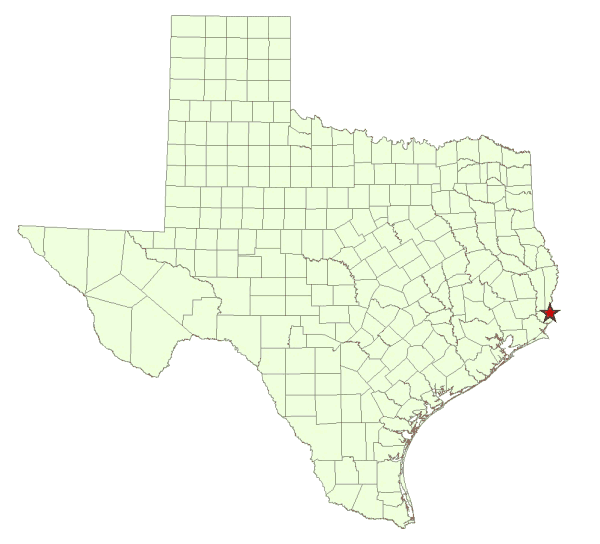
Work Session Item No. 15
Exhibit B
Vicinity Map for Adams Unit Lower Neches WMA in Orange County
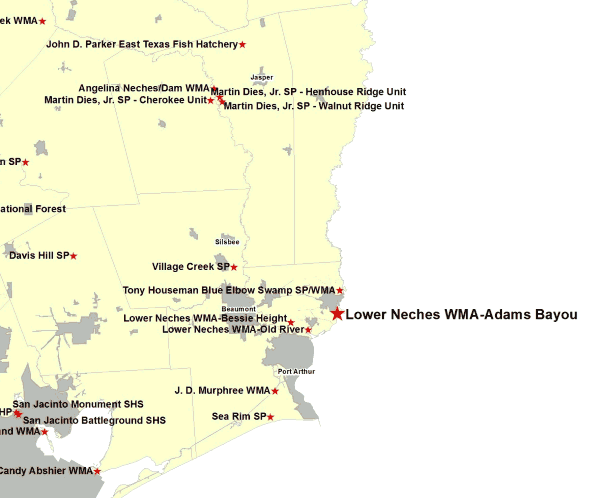
Work Session Item No. 15
Exhibit C
Site Map Adams Unit Lower Neches WMA Showing Route of Proposed Gathering Line
